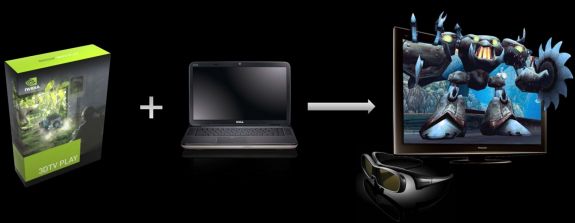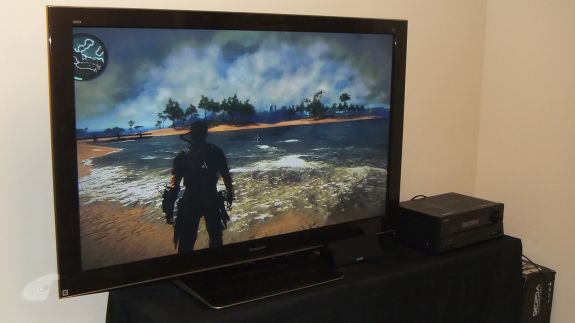NVIDIA Launches 3DTV Play, Bringing 3D Vision to the Big Screen
by Ganesh T S on October 21, 2010 9:01 AM ESTEarlier this year, NVIDIA quietly announced 3DTV Play, a driver add-on for 3D TV owners that would allow them to take full advantage of the HDMI 1.4a port on their 4xx GPUs / 3D Vision GPUs by enabling 3D over HDMI. Without 3DTV Play, the NVIDIA 3D PC experience had been restricted to NVIDIA 3D Vision capable monitors with specialized glasses, and for 3D TVs the experience was limited to just Blu-Ray 3D. Now after some months in limbo, 3DTV Play is finally being released and shifts this experience to the big screen.
Introduction
It is no secret that TV makers are heavily betting on 3D becoming popular to drive sales. However, the market reception has been lukewarm at best due to two reasons. First, 3D TVs are not the ideal home experience due to the necessity for glasses and the health warnings associated with 3D content viewing. Secondly, there is a lack of content from the perspective of both console games and Blu-Ray movies to shift consumers to 3D TVs. There are very few channels broadcast in 3D, and the cost associated with covering events and programs in 3D is much more than the standard 2D broadcast. Studios are unwilling to invest much further in this till the consumer demand for such channels increase. In this scenario, the PC platform emerges as the leading provider for 3D content. In addition to a large number of 3D game titles, we are also starting to get user generated 3D content such as those from the recently introduced Fujifilm 3D camera and Panasonic camcorders. With years of development for the 3D ecosystem behind them, NVIDIA has taken up the opportunity to bring it to the TV platform with 3DTV Play.
Technical Details
3D Vision has been around for quite some time, and it uses a dual link DVI connector to supply the 120Hz refresh rate necessary to sync with shutter glasses in order to provide a 3D effect. With the bandwidth available in dual link DVI connectors, it is possible to push across 120Hz signals at up to 1920x1200 for a smooth HD 3D experience. Unfortunately, 1080p60 (120Hz actual, 60Hz per eye) is not part of the HDMI 1.4a standard. Present day 3D TVs support upto 720p30 and 1080p24 for 3D signals. These are the type of video signals which 3DTV Play enables over the HDMI port of the 4xx GPUs. With 3DTV Play, consumers can experience 3D games and photos on their big screen TV.
From a developer perspective, the handling of the display of 3D games on a 3D TV is transparent. The game developer needs to develop only for 3D Vision and 3DTV Play handles the rest. And of course playback of 3D movies over HDMI onto a 3D TV already works and doesn't require this add-on.
Business Partners
Dell launched their new lineup of XPS laptops today. Featuring GF108 GPUs from NVIDIA, all of them have HDMI 1.4a ports. 3DTV Play comes bundled with the laptops. In addition to Dell, systems from ASRock (the Vision 3D, which we already reviewed) and some upcoming systems from Zotac also have this add-on bundled. Frankly GF108 systems aren't going to be the best examples of 3DTV Play, given the heavy overhead of stereoscopic rendering in games. The best platform for 3D gaming would be using GF104 (and ideally a pair of them), which at the moment may be a bit hard to swallow in an HTPC.
For consumers already in the NVIDIA 3D ecosystem (i.e. own a 3D Vision kit), 3DTV Play will be a free upgrade. Consumers without a 3D Vision kit but interested in using 3DTV Play with their TV's existing hardware will need to purchase it from NVIDIA for $39.99.
Charging for what is essentially a driver update might be a little hard to digest. However, the fact remains that people wanting to purchase 3DTV Play standalone are those who have invested in a 3D TV before the technology goes mainstream. $40 for a value add-on is probably not much for such consumers.
As we said in the GT 430 review, lots of companies are betting on consumers getting enamored by 3D for the upcoming holiday season. ATI will also be getting into the action soon with their 6xxx series GPUs. How important is 3D technology to you? Feel free to echo your thoughts in the comments. Your opinion will be one of the important factors which influence our coverage in this area.













28 Comments
View All Comments
mcnabney - Thursday, October 21, 2010 - link
The 3D BS is standing in the way of moving to 4k resolutions. Anything that requires the adjustment of vision is generally a niche product. People want things simple. Prjoectors have not taken over despite their compact size and intrinsic flat screen due to the requirement of darkness to watch the content. Tossing 3D into the mix of content will be a huge headache of having to keep expensive glasses nearby and take them off / put them on when the content changes. We could do 4k right now. Sony has had multilayer BDs that hold 100GBs for a few years. Most film masters and all of the scanned/archived content was done at ~4k which is the resolution limit of 35mm film. Displays for 4k have been out for some time now. This is the shift that makes the most sense due to the resolution being a plateau. It is the maximum image sharpness of 100 years of film. We have the exact audio, might as well have the exact video.mac2j - Thursday, October 21, 2010 - link
I think its a stretch to say that 3D-capable TV development is hindering the move to 4K. 3D has just given them a way to get a slightly higher profit and larger market to buy into the higher contrast and frequency models.The major manufacturers sadly have plotted a slow scale up in resolution where we should see the first 1440p TVs next year ... 2160p in the next 5-7 years and 4K a few years after that. The only marginally good news is that a few companies demoed 2160p TVs at CES but none of them are being targeted at the consumer market any time soon.
It seems like the limiting factor for even a low-medium resolution holographic 3D display (besides the obvious current lack of a good holographic projection system) might not be the processing power or data storage but the transmission bandwidth where we'd need 1000-10000x the current available maximums.
mcnabney - Friday, October 22, 2010 - link
1080p is 'almost' 2k.1920x1080 is current HD
2048x1152 is 2k - not a big difference, although some 2k is less letterboxy
4096x3072 is the actual 3:2 4k standard, although it is more likely to see the HDTV resolution land at 4x1080p or 3840x2160. I have seen images and video at this resolution on demonstration kiosks and the image is absolutely spectacular. I would also point out that there is no need to make 4k televisions at sizes under 40" since nobody will sit close enough to see the difference. However, computer users can enjoy these displays right now, if you want to spend the money.
Vengeful Giblets - Thursday, October 21, 2010 - link
"How important is 3D technology to you?"Not at all important. The only reason why I'd ever own a 3D TV is because the feature happens to be built into a TV that I otherwise want. This is unlikely to happen any time soon because...
a.) this "feature" drives the price way up and there's no way that I'm spending that much on a TV
b.) I already have an HDTV for the living room and it works perfectly fine
c.) I have a small HDTV for the kitchen
d.) ergo It's not necessary to buy another one
yammerpickle2 - Friday, October 22, 2010 - link
I've worn corrective glasses for over two decades and I'm forty five years old so my eyes are not what they used to be. I've watch several 3D movies and demo's using the glasses over my normal glasses without a problem. Not saying I'd like to wear the glasses for 12 hours in a row, but 3 or 4 hours at time is no big deal. I have a big bright 54" Samsung non 3D HDTV that I love, but am willing to go out and get the gear for a 3D gaming rig. However, nobody can show me that 3D stereo surround works with 3 nice 50" plasmas at a native 3X1920X1080X60hzX2. I'd even love it more if the monitors where 4K with razor thin bezels. Sadly, even quad water cooled and overclocked GTX480's can not support that sort of resolution.jojojo36 - Monday, November 8, 2010 - link
Dear customers, thank you for your support of our company.Here, there's good news to tell you: The company recently
launched a number of new fashion items! ! Fashionable
and welcome everyone to come buy. If necessary,
welcome to :===== www. soozone .comC
Dipponhopper - Saturday, November 13, 2010 - link
Generally small screen means TV, so TV movies, TV shows, etc. Big screen is cinematic releases.http://bodyquickmuscle.com/
Triple C - Tuesday, December 7, 2010 - link
.It's been baffling to me to see so many negative attitudes towards this amazing technology. Right now I"m working on my 65" 3D Panasonic - Put on my glasses, and a fantastic game, like Half LIfe 2 and I'm blown away - Watch a 3d Nature documentary - It's like I'm there - EVERYONE who's come to my house and watche the 3d content is blown away. The 3d games are totally immersive, the sense of proximity in the nature shows changes the relevance of viewing entertainment. In regards to folks complaints of flickering - I suggest you dont' watch it in a room with bare neon lights that run at 60hz Neon lighting is bad to begin with, but couple that with 60hz per eye frame switching and you have a recipe for a bad experience.
Why express so much negativity around this new technology? It's far out man.. This is progress folks - science has delivered us another step towards fully immersive environments -
In regards to hurting your eyes - you do have to relax and not strain - some folks can't relax easily, I understand, but if you try not to force seeing it in 3d it gets alot beter. Could be your setup as well of course.